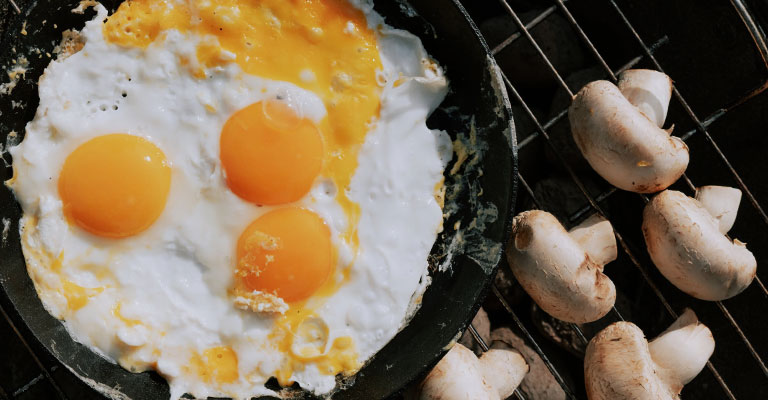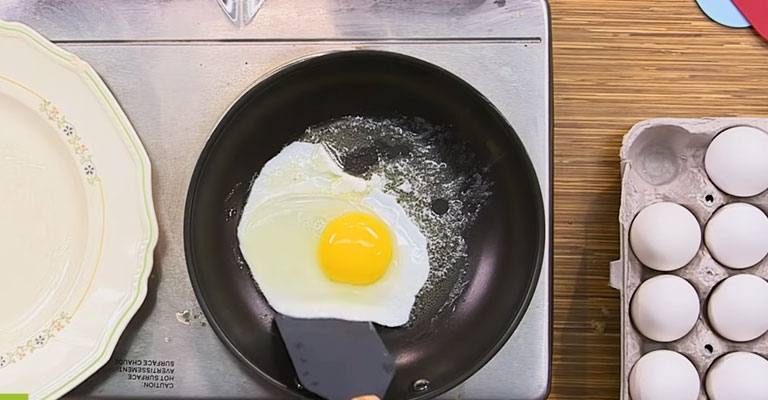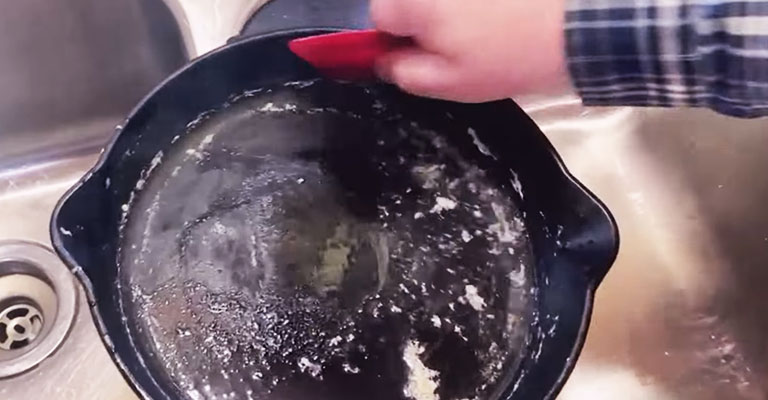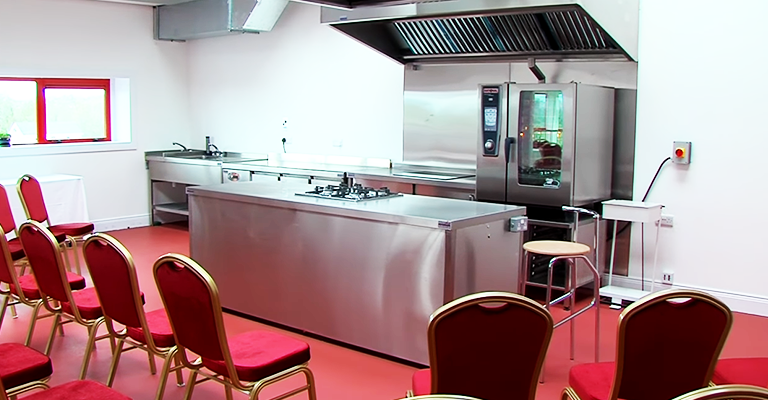Why Do Eggs Stick to Pan?- Reasons and Proven Prevention Techniques
Cooking eggs can be a delicate art, but the frustration of them sticking to the pan is a common culinary challenge. Understanding the science behind this phenomenon is essential for achieving that perfect, non-stick result.
Several factors contribute to eggs adhering to the pan’s surface, ranging from temperature control to the quality of cookware.
Additionally, the choice of fats and utensils plays a crucial role. In this discussion, we’ll explore the reasons behind eggs sticking and provide practical tips to ensure a seamless cooking experience.
By mastering these fundamentals, you’ll be equipped to create flawlessly cooked eggs that effortlessly release from the pan.

Why Do Eggs Stick to Pan?
Eggs sticking to a pan is a common kitchen frustration, but there are several reasons why it happens. Understanding these factors can help you take steps to prevent it in the future.
Here are some of the main reasons why eggs stick to a pan:
1. Pan Temperature
Achieving the right pan temperature is an art. Too high, and the proteins in the egg white coagulate too quickly, forming a stubborn bond with the pan’s surface.
It’s crucial to find the sweet spot where the eggs cook evenly without sticking. This often involves starting with a medium heat and adjusting as needed.
2. Lack of Fat
Eggs, especially when cooked without additional ingredients, lack the natural fats necessary for non-stick cooking.
Introducing butter, oil, or a non-stick cooking spray forms a protective layer between the egg and the pan. This not only prevents sticking but also imparts flavor and texture to the eggs.
3. Quality of Pan
Investing in a high-quality pan is a game-changer. Cheaper pans may have uneven surfaces or wear down quickly, creating pockets where eggs are more likely to stick.
A well-seasoned cast-iron pan or a quality non-stick surface provides a smooth, reliable cooking experience.
4. Not Enough Preheating
Preheating ensures that the pan is uniformly hot, allowing the eggs to cook consistently.
Placing eggs in a cold pan increases the likelihood of sticking, as they’re more likely to adhere to the surface. Give the pan a few minutes to reach the desired temperature before introducing the eggs.
5. Freshness of Eggs
The age of the eggs can impact their consistency. Older eggs tend to have thinner whites, which can spread more thinly in the pan.
This increases the likelihood of sticking. Fresher eggs with thicker whites are less likely to spread and stick, resulting in a smoother cooking process.
6. Agitation and Overmixing
Overmixing eggs can lead to a more liquid consistency, which is more likely to stick to the pan. It’s best to gently beat the eggs until just combined.
This maintains their structure and reduces the chances of them adhering to the pan’s surface.
7. Using the Wrong Utensils
Metal utensils can scratch non-stick surfaces, which reduces their effectiveness and increases the likelihood of sticking.
Opt for utensils made of silicone, wood, or nylon to preserve the integrity of the pan’s surface and ensure a smooth cooking experience.
8. Not Enough Patience
Patience is key when cooking eggs. Trying to flip or move the eggs too soon can cause them to tear or stick.
Allow them to set and cook for a bit before attempting any maneuvers. This allows the proteins to firm up, making them easier to handle.
9. Not Enough Lubrication During Cooking
During the cooking process, the eggs may absorb some of the initial fat, potentially leaving the pan’s surface less lubricated.
Adding a little more fat around the edges of the eggs can help prevent sticking and maintain a non-stick cooking environment.
10. Residue from Previous Cooking
A clean pan is essential for preventing sticking. If the pan wasn’t cleaned thoroughly after its last use, any leftover residue can cause the eggs to adhere.
Always make sure the pan is free of any remnants before cooking eggs to ensure a smooth, non-stick experience.
The Science Behind Egg Sticking

The science behind eggs sticking to a pan primarily involves the chemistry and physics of cooking.
Several factors come into play:
Protein Denaturation
The proteins in eggs, mainly albumen (egg white) and ovomucin denature or unwind and bond together as they heat up.
This denaturation is essential for the solidification of eggs, but it can also cause them to stick to the pan. When proteins bond with the metal surface of a pan, it creates adhesion, leading to sticking.
Formation of Maillard Reaction
The Maillard reaction is a chemical reaction between amino acids (from proteins) and reducing sugars that occurs at higher temperatures.
It’s responsible for the browning of the egg’s surface. This browning can lead to sticking if the heat is too high or if there’s not enough fat to separate the egg from the pan.
Water Evaporation
As eggs cook, water within them turns into steam and tries to escape. The steam can sometimes get trapped between the egg and the pan’s surface, creating pressure and causing the egg to stick. The right amount of heat and fat helps manage this issue.
Non-Stick Coatings
In non-stick pans, a layer of PTFE (polytetrafluoroethylene) or ceramic coating provides a smooth surface that resists sticking.
These coatings work by preventing the proteins in the eggs from bonding with the pan’s surface. Over time, wear and tear or overheating can damage the non-stick coating, increasing the likelihood of sticking.
Heat Transfer
The even distribution of heat across the pan can influence whether eggs stick.
Hot spots in a pan can cause some parts of the egg to cook too quickly, leading to sticking. Using a well-designed, high-quality pan can help mitigate this issue.
Fat Barrier
Adding a source of fat, such as butter or oil, creates a physical barrier between the egg and the pan. This barrier not only prevents sticking but also adds flavor to the eggs.
Techniques for Preventing Stickiness

Preventing the sticking of eggs in a pan involves a combination of proper techniques and a good understanding of the science behind it.
Here are some effective techniques to help you enjoy non-stick egg cooking:
Use the Right Pan
Investing in a high-quality pan is paramount. Non-stick pans with a durable coating or well-seasoned cast-iron skillets offer a smooth, reliable surface. They distribute heat evenly and reduce the likelihood of eggs adhering.
Preheat the Pan
Giving the pan ample time to heat up is crucial. This ensures that the entire surface reaches an even temperature, minimizing the risk of sticking.
Starting with medium heat provides a good balance, but adjustments may be necessary based on your stove’s specifics.
Add Sufficient Fat
Butter, oil, or non-stick cooking spray act as a protective barrier between the eggs and the pan.
Evenly spread the fat across the pan to ensure complete coverage. This not only prevents sticking but also adds flavor and richness to the eggs.
Use the Right Utensils
Opt for utensils made of materials like silicone, wood, or nylon. These won’t scratch or damage the non-stick surface.
Metal utensils should be avoided, as they can compromise the integrity of the pan’s coating.
Don’t Overmix
Gently beat the eggs until just combined. Overmixing can lead to a more liquid consistency, increasing the likelihood of sticking. Aim for a smooth but not overly blended mixture.
Fresh Eggs
Fresher eggs typically have thicker whites. These are less likely to spread thinly in the pan, reducing the risk of sticking.
Choosing fresh eggs can make a noticeable difference in your cooking experience.
Practice Patience
Allow the eggs to set and cook for a bit before attempting any maneuvers. This grants the proteins time to firm up, making them easier to handle and less likely to stick to the pan’s surface.
Lubricate During Cooking
When you notice that the eggs are absorbing the initial fat and the pan’s surface is drying out, consider adding a touch more fat around the edges of the eggs. This ensures a consistent non-stick environment throughout the cooking process.
Clean Your Pan
A clean pan is essential for preventing sticking. Make sure it’s free of any residue from previous cooking. Lingering remnants can cause the eggs to adhere, even if you’ve followed all other precautions.
Manage Heat
Be attentive to the heat level throughout the cooking process. Adjusting the heat as needed helps maintain the right temperature.
Lowering the heat as the eggs cook can prevent overcooking and sticking, especially if you’re aiming for a specific level of doneness.
Alternative Cooking Methods
There are alternative cooking methods that can be employed to prepare eggs without the risk of sticking to a pan. These techniques offer different approaches to achieve the desired texture and flavor.
Here are some effective alternative methods:
Poaching
Poaching eggs involves gently simmering them in water, typically with a splash of vinegar to help the whites coagulate.
This method yields soft, runny yolks encased in delicate whites, without the need for any fat. It’s a healthier option and ensures a clean, non-stick cooking process.
Steaming
Steaming eggs provides a gentle, even heat that cooks them without sticking. It’s an excellent method for producing perfectly set whites with creamy yolks.
Simply place the eggs in a steamer basket over simmering water and cover with a lid.
Baking
Baking eggs in the oven is a hands-off approach that eliminates the need for direct contact with a pan.
By placing eggs in a greased ramekin or muffin tin, you can achieve consistent, non-stick results. This method is versatile and allows for easy customization with additional ingredients.
Microwaving
Although unconventional, microwaving eggs can yield quick and easy results.
By using a microwave-safe dish and covering the eggs, you can prevent sticking. However, it’s important to monitor the cooking process closely to avoid overcooking.
Sous Vide
Sous vide involves immersing eggs in a precisely controlled water bath.
This method ensures even cooking and prevents any contact with a pan surface. It’s an excellent way to achieve precise results with both the whites and yolks.
Egg Cookers
Specialized egg cookers provide a convenient way to prepare eggs without sticking.
These appliances often include non-stick surfaces and precise temperature control, ensuring consistently non-stick results.
Silicone Molds
Using silicone molds can be an effective way to cook eggs without sticking.
These molds are naturally non-stick and can be used in various cooking methods, such as steaming or baking.
Non-stick skillet or Griddle
When using a regular pan is unavoidable, ensuring it’s of high quality with an intact non-stick coating is crucial.
Additionally, using a flat griddle can provide more surface area and even heat distribution, reducing the chances of sticking.
Tips for Flipping and Removing Eggs

Flipping and removing eggs can be a delicate process, especially if you want them to remain intact and presentable.
Here are some tips to help you do it smoothly:
Flipping Eggs
- Use the Right Utensil
- A thin, flexible spatula works best for flipping eggs. Look for one with a wide surface to provide good support.
- Non-Stick Pan: Ensure you’re using a non-stick pan, as it significantly reduces the likelihood of the eggs sticking during the flip.
- Wait for the Right Moment: Don’t rush it. Wait until the edges of the egg whites are set and the center is slightly jiggly but not runny. This indicates that it’s ready to be flipped.
- Angle of Attack: Tilt the pan slightly towards the edge where you’ll be flipping. This allows for easier access to the spatula.
- Confident Wrist Motion: Use a confident, quick wrist motion to slide the spatula under the eggs. Gently lift and flip in one smooth motion.
Removing Eggs
- Slide, Don’t Scrape: When removing eggs from the pan, use a gentle sliding motion rather than scraping or prying. This helps maintain their shape.
- Tilt the Pan: Tilt the pan slightly towards your spatula or utensil. This makes it easier to slide the eggs onto the plate.
- Use a Fish Spatula: A fish spatula, with its thin, flexible blade, is excellent for gently lifting and transferring eggs without breaking them.
- Plate with Care: Choose a plate or surface that has a gentle slope. As you slide the eggs onto it, the natural inclination will help keep them intact.
- Consider Using a Silicone Spatula: If you’re concerned about scratching non-stick surfaces, a silicone spatula can be a gentle alternative.
Cleaning and Maintenance of the Pan

Proper cleaning and maintenance of your cooking pan are essential to ensure its longevity and continued effectiveness.
Here are some tips to keep your pan in great condition:
Cool Down Before Cleaning
Allowing the pan to cool down before cleaning is crucial for its longevity.
Rapid temperature changes, such as placing a hot pan in cold water, can lead to warping or even cause the non-stick coating to peel.
Use Warm Water and Mild Soap
When washing your pan, use warm water and mild dish soap. This combination effectively removes most food residues without being too harsh on the pan’s surface.
Avoid using harsh or abrasive cleaners, as they can strip away the non-stick coating.
Avoid Soaking for Extended Periods
While it’s acceptable to let the pan soak for a short while to loosen stubborn residues, avoid leaving it submerged for an extended period.
Prolonged soaking can potentially weaken the non-stick coating and lead to premature wear.
Use a Soft Sponge or Cloth
Opt for a soft sponge or cloth when cleaning your pan. Abrasive scouring pads or steel wool should be avoided, as they can scratch and damage the non-stick surface.
Avoid Metal Utensils
For pans with non-stick coatings, steer clear of using metal utensils. They can easily scratch the surface, compromising its non-stick properties. Instead, opt for utensils made from materials like silicone, wood, or nylon.
Remove Stubborn Residues Gently
If you encounter stubborn residues, a mixture of warm water and baking soda can be effective.
Create a paste and gently rub it onto the residue using a soft cloth or sponge. This method is less abrasive than using scouring pads.
Avoid Cooking Sprays with Silicone
While non-stick cooking sprays can be convenient, avoid using ones that contain silicone. Over time, these sprays can create a buildup on the pan’s surface, potentially affecting its non-stick properties.
Dry Thoroughly
After washing, take the time to thoroughly dry the pan with a clean towel. This helps prevent water spots or mineral deposits from forming on the surface.
Store Properly
When you need to stack pans for storage, place a soft cloth or paper towel between them to prevent scratches.
Alternatively, consider hanging pans or storing them with lids to protect the cooking surface.
Seasoning
For cast iron pans, occasional re-seasoning helps maintain their non-stick properties.
This involves applying a thin layer of oil and heating the pan in the oven to create a protective layer.
Inspect for Wear and Tear
Regularly check your pan for signs of wear, such as deep scratches or a deteriorating non-stick coating.
When you notice significant damage, it may be time to consider replacing it to maintain optimal cooking performance.
FAQs
Why do eggs stick to the pan even when using oil or butter?
Even with oil or butter, eggs can stick if the pan isn’t properly preheated or if it’s not a high-quality non-stick surface.
Can using a metal spatula contribute to eggs sticking?
Yes, using a metal spatula on a non-stick surface can scratch the coating, making it less effective over time.
Do fresher eggs stick less than older ones?
Yes, fresher eggs tend to have thicker whites that spread less thinly in the pan.
Is it possible for non-stick pans to lose their effectiveness over time?
Yes, non-stick pans can wear down or become scratched, reducing their effectiveness.
Can preheating the pan too much cause eggs to stick?
Yes, if a pan is too hot, the proteins in the egg can coagulate rapidly, causing them to adhere to the surface.
To Recap
Eggs stick to a pan due to a combination of factors. The pan’s temperature plays a critical role, with excessive heat causing proteins to coagulate too quickly.
Inadequate lubrication, whether from insufficient fat or improper preheating, can also lead to sticking. Quality matters, as low-quality or damaged pans create uneven surfaces that encourage adhesion.
Additionally, the choice of utensils and proper handling are vital in preserving the pan’s non-stick properties.
Understanding these elements empowers cooks to take precise measures, ensuring that eggs release effortlessly, resulting in beautifully cooked dishes.
With the right techniques and attention to detail, a non-stick cooking experience is within every kitchen’s reach.

